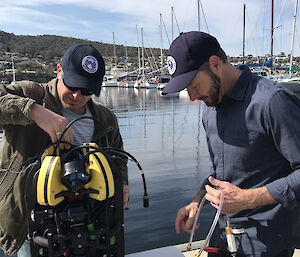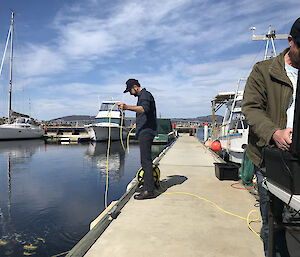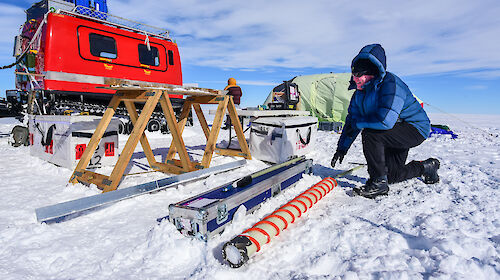A sophisticated underwater mini submersible designed and built in Tasmania, will spend the summer in Antarctica exploring under the sea ice at Australia’s Davis research station.
The mini sub, or Remotely Operated Vehicle (ROV), has been purpose built for Antarctica and is packed with hi-tech features including lasers that can measure the size of objects on the sea floor.
Australian Antarctic Division scientist and ROV pilot, Dr Glenn Johnstone, said the $60,000 machine was designed to fit down a 40cm hole in the sea-ice.
“One or two scientists can take this small sub out onto the sea ice, drill a hole and lower it in to do the same work we would have previously used a team of divers to do, which required significant logistics and equipment,” Dr Johnstone said.
The ROV measures 35cm in diameter, and will carry three cameras as it explores up to 30 different sites around the station. It can dive down to 100m below the sea ice and spend 3–4 hours exploring.
“This season, we’re focused on learning the capabilities of the sub and testing a range of methods and techniques to develop a long-term monitoring program,” Dr Johnstone said.
“We have a reasonable understanding of the habitats in the coastal areas around Davis research station, but we know very little about the surrounding Fjords and a ROV is the most efficient way of exploring these areas.”
The ROV was built by Southern Ocean Subsea (SOSub) located in Kingston, south of Hobart.
SOSub Director Peter Colman, said designing and building the Antarctic-bound ROV was an interesting challenge.
“The sub was designed to be as agile as a modern aerial drone, with technology that’s known in the ROV industry as ‘six degrees of freedom’ which means it can move in any direction whilst holding any altitude, much like a spacecraft,” Mr Colman said.
“Our use of 3D computer aided design and manufacturing were essential to the project, particularly given the very small size of the ROV and the timeframe we had to design and build it.”
Dr Johnstone said the sub can also be modified to dive deeper and collect samples.
“It’s like a meccano set in that we can change the capabilities as we need,” he said.
“We can use 3D printing to produce customised brackets to mount different types of scientific instruments to meet future research needs.”
“By changing the electronic housings, the ROV could also dive down to depths of 300m.”
This research is part of the environmental baseline data gathering for Australia’s plan to build a paved runway near Davis research station, subject to environmental approvals.
The data collected by the mini submersible will be included in the impact statements and extensive environmental assessment processes.
The ROV technology developed through this research could become an important tool in Australia’s broader long-term environmental monitoring program in Antarctica.



